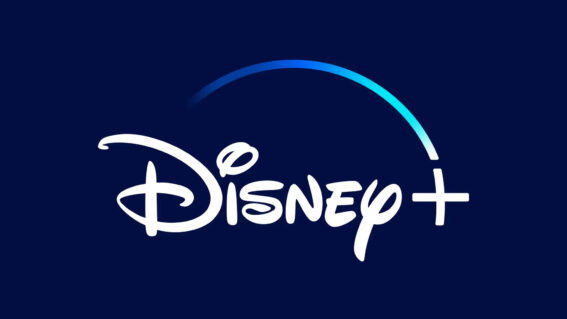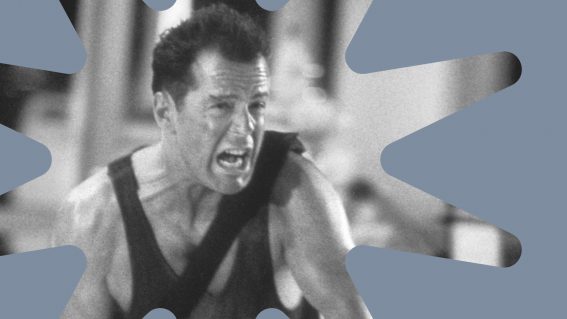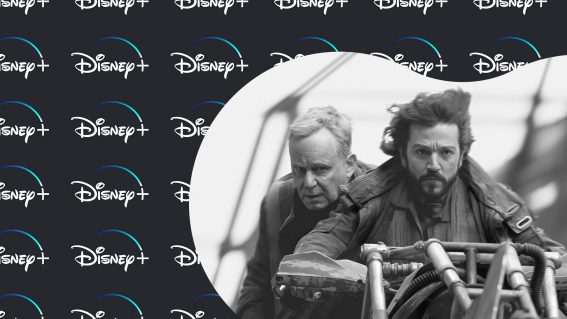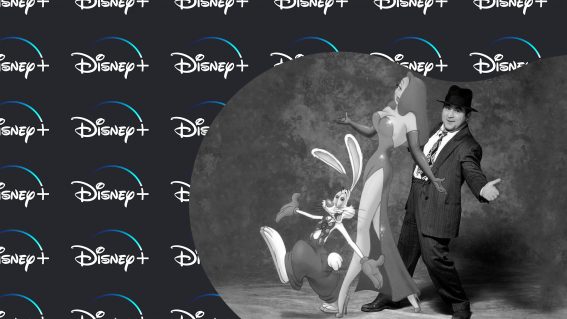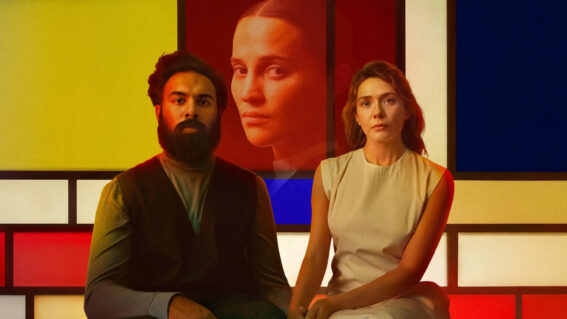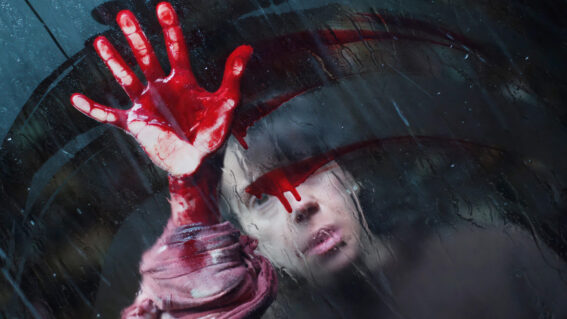*points* GODZILLAAAAAaaaa!!!!
I am a Godzilla (or ‘Gojira’ to use the original Japanese pronunciation) fan. Among my favourite memories as a kid, growing up in California, was tuning in at 10am to our local KTX-TV station for the weekly Super Scary Saturday movie, a Vampire/Elvira-format show hosted by Grampa Munster (I’m serious, actual Grampa-freakin’-Munster) who would show […]
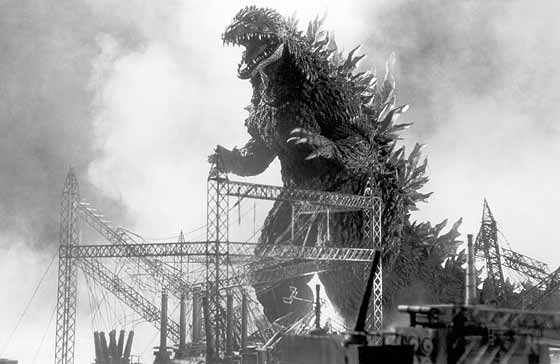
I am a Godzilla (or ‘Gojira’ to use the original Japanese pronunciation) fan.
Among my favourite memories as a kid, growing up in California, was tuning in at 10am to our local KTX-TV station for the weekly Super Scary Saturday movie, a Vampire/Elvira-format show hosted by Grampa Munster (I’m serious, actual Grampa-freakin’-Munster) who would show old B-films, black and white horrors, giant monster films and, once every month, an epic Godzilla flick. More than just a pop icon, Godzilla is a cultural phenomenon that is deeply seated in the modern consciousness of Japan (even if the quality of the films are often better left to the mists of time) and, when executed right, a powerful metaphor regarding humanity’s position in the grand scale of our planet and of the subconscious fears about our demise and by what powers it may come about.
Godzilla represents some of the best in movie-making and also some of the worst, with an awesome starring role in 51 films to date and still counting! So, if you’re a fan of the Big-G or if you’ve never seen a Japanese Kaiju film and want to know more, walk with me as we go through a quick stroll into the world of GODZILLA!
A quick history lesson:
In early 1950’s, Hollywood cinema entered a phase known today as the “B-Movie Craze” where studios, smartening up to the comic-book and sci-fi literature fed audience of the day, began rolling out a series of high-concept monster, alien-invasion and science-fiction films which relied on visual effects and spectacle rather than name-stars and directors (hence they were B-list films, rather than A-list). Perhaps taking liberal inspiration by the success of that one great Jurassic-Park-level monster hit of 1933 – King Kong – a slew of giant monster films erupted out of Hollywood, starting with a classic, serious-in-a-stupid-way, spectacle film The Beast From 20,000 Fathoms.
Meanwhile that same year, but half a world away: a nuclear test at Bikini Atoll goes horribly wrong. A hydrogen bomb code-named Castle Bravo, being tested by the United States Military, explodes with more than twice the megatonne yield than was originally calculated. Radioactive fallout saturates several US warships observing the test as well as the crew of a Japanese fishing vessel named Lucky Dragon 5. The accident, less than ten years after the U.S. decimated the civilian populations of Hiroshima and Nagasaki with their atom bombs Fat Man and Little Boy, stirred the memories of the entire nation of Japan and gave inspiration to a film producer named Tomoyuki Tanaka, who was hired at the time by Toho Films (the same Japanese studio who released most of Kurosawa’s famous samurai epics) to create a Japanese answer to the Hollywood giant-monster B-movie.
The following year, after a slew of false starts and creative U-turns, Toho released a film that would forever change the landscape of Japanese popular culture. It was called Gojira (a portmanteau of the Japanese words for ‘gorilla’ and ‘whale’) and was unlike anything the world had ever seen. A 100-meter tall mutated, radio-active, dinosaur the breathes atomic-energy fire, reminiscent of the dragons of ancient mythology, that effectively enters the foodchain above human beings and deliberately, and cruelly, lays waste to civilization. The creature is bullet-proof, explosive-proof and even absorbs electricity and nuclear radiation to become stronger and more dangerous.
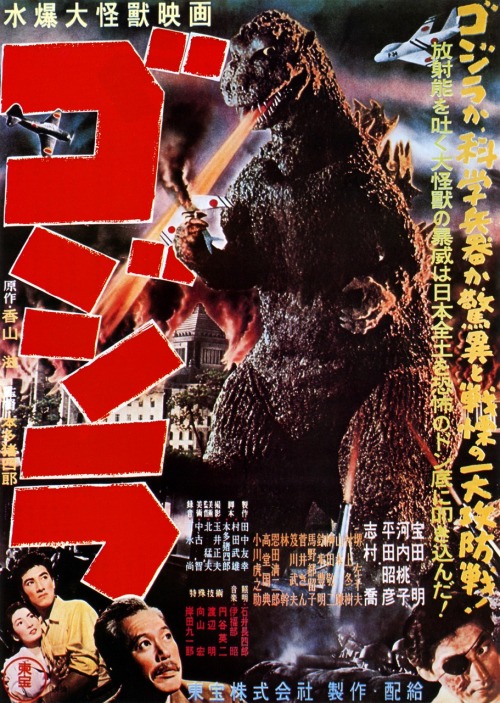
Original 1954 Japanese release poster.
What makes the original film a classic, and pretty much sells why you HAVE to see it, is that Gojira isn’t just a straight-forward monster movie. The film is an entire nation’s collective subconscious about the horrors of atomic energy splashed onto the screen, motivated by the fact that they (to date still) are the only people in the world to have ever suffered the effects of a nuclear attack. Director Ishiro Honda laces the entire film with deeply consequential dialogue about karmic responsibility and assaults the viewers with images of the radioactive monster’s victims which are copied, shot-for-shot, from actual photographs and film taken of Hiroshima and Nagasaki radiation victims. The rest of the film follows a group of characters whose lives are devastated by the arrival of the monster, particularly an academic (played by Seven Samurai bad-ass Takashi Shimura) who first realizes that it’s a product of nuclear testing and another scientist who has developed a weapon that could potentially kill the monster, but also be used as a weapon of war. Gojira is pure, deliberate, metaphor intermixed with impressive special effects, a top-notch cast for the period and genuine poignancy and horror inspired by actual atrocity of experiencing a nuclear strike. The film’s theatrical trailer pretty much exemplifies it all.

A still from "Gojira" (1954)
This film is where my love for Godzilla started, though I will freely admit that in the 50 sequels that followed none has ever got close to the genuine gravity and execution that the original pulls off. But for Japanese pop culture, this is where it starts – giant Japanese monsters (daikaiju such as Mothra, Rodan, Gamera and more), visions of Japan’s apocalyptic destruction (e.g. in films like Akira), giant transforming gestalt mecha (invented to fight the giant monsters in shows like Power Rangers to Voltron) and the old-time tradition of stuntmen duking it out in oversized monster suits (which, most of the time, is done far worse than what you see in some of the better Godzilla films). Incidentally the popular international name “Godzilla” comes from the 1955 American dubbed version of the film, entitled Godzilla: King Of The Monsters where the studio distributing the film actually shot and (badly) spliced in large chunks of footage of American actor Raymond Burr as an eye-witness reporter/main-character who experiences the monsters rampage first-hand. The name stuck and is the name the creature is known as outside of Japan. Don’t let the label fool you though, the American version is not worth your time. Stick to the awesome Japanese original. Read the damn subtitles.
Now. If you want to watch Godzilla films beyond the classic original (and you really should try a couple, especially if you’re lucky enough to see them on a big screen) then there’s a few things you need to know. First, Godzilla films are essentially split into three different periods: Showa, Heisei and Millennium. The former two being named after the family of the Emperor ruling at the time (Emperor Showa who passed in the 1980’s and Emperor Heisei who reigns currently). The latter is named for the new Godzilla brand films launched after the year 2000 (obviously).

Showa-era Godzilla with monster co-stars and Toho creators.
The Showa-Era films (1954 – 1975) started with the original classic Gojira and then spanned for 14 sequels, dramatically decreasing in violence, drama and increasing in camp-factor, kid-friendly silliness and odd-ball rock n’ roll sci-fi with each iteration. After the first film, the big green guy returned in a much-anticipated sequel Godzilla Raids Again (1955) which featured the world’s first ever giant-monster battle where he fights a four-legged spiny creature known as Anguirus. The sequel seemed to strike a nerve with younger audiences who loved the titanic monster battle and Toho then knew they had a formula for a franchise. For their next release, Toho made the leap to filming in color and pitted the fire-breathing lizard against none-other-than King Kong himself! Of course it didn’t matter that the original Kong would barely come up to Godzilla’s knee, they blew the giant ape to daikaiju-size and let the two monsters smash the shit outta Tokyo in King Kong vs Godzilla (1962). From that point on, Toho went into overdrive trying to find new monsters for Godzilla to fight – Mothra the giant moth, Ghidorah the Three-Headed Golden Dragon from outer space, Ebirah the giant lobster, even an evil robot version called MechaGodzilla. In the process, Godzilla turns slowly – with each film – into a protector of Japan and children’s hero (Toho’s reasoning, like any money-obsessed corporate, that kids will earn them bigger merchandising bucks, but not realizing that kids are fickle and will grow up and not sustain your income in perpetuity). By the time Godzilla films entered the 1970’s, the monster’s suit design came with semi-googly eyes that made him look like Cookie Monster and there are even a couple of entries where the big guy flies through space using his atomic breath, talks to other monsters (with speech bubbles!) and even does the Safety-Dance. Check this crazy shit out:
As you can tell from that clip, the production values of the films had fallen dramatically as Godzilla films increasingly targeted young children which gradually shrank the audience and budget of subsequent films. The human story-lines in each film also became irrelevant and operated as stock-standard filler to cut between the monster battles.
Now don’t get me wrong here.
If you like wanton destruction, explosions, giant monster wrestlemania and embarrassingly hilarious retro-1960’s fashion and music, there’s still a lot of so-awful-it’s-good enjoyment to be had with these titles, especially with films like Godzilla vs The Smog Monster (aka Godzilla vs Hedora) which is a part-environmental-message film and part-LSD–acid-trip with bizarre musical numbers or Godzilla vs The Sea Monster where the title character’s storyline is completely unrelated to the human storyline (which is about drug smugglers) and our big green hero wanders around a tropical island as if he’s nursing a bad hangover and simply beats up random creatures and buildings whenever the plot in the other storyline starts to get stale. There’s even the face-palmingly-bad Godzilla’s Revenge which is a part-clip-show from other Godzilla films and part-Never-Ending-Story-esque dream sequence where a young bullied boy makes friends with Godzilla’s talking-son Minya (who looks like South Park’s Mr Hankey The Chrismas Poo) and apparently gets bullied by bigger monsters because he can’t breathe fire. Starting from the obvious high note of the original, the Showa-Era is a non-stop psychedelic blast of bizarre filmmaking that finally came to an end with three films that, again, were mostly pieced out of stock footage and featured fight-sequences where the Cookie-Monster Godzilla suit actually falls apart on-camera in some sequences.
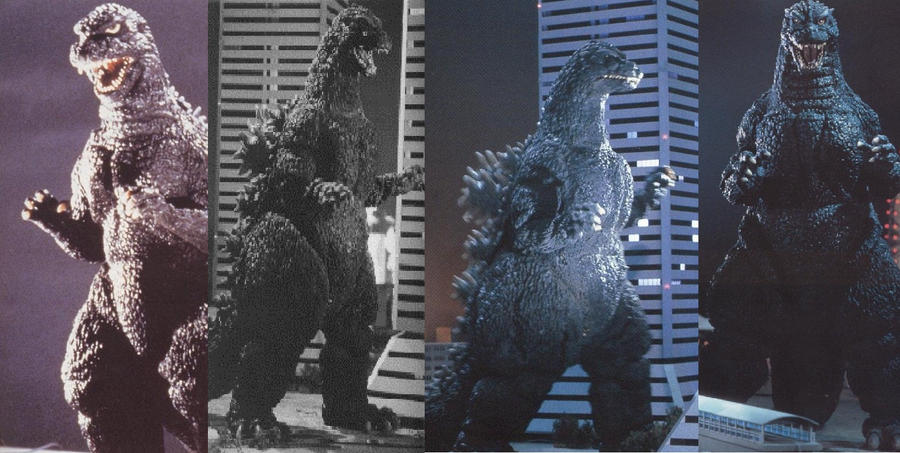
Heisei-era Godzilla suits
The Heisei-Era (1984 – 1995) began when Toho decided to resurrect/reboot the franchise for its 30th anniversary, after it had fallen out of public interest in the late 70’s. Their solution was to make The Return of Godzilla (1984) which was a direct sequel to the original film and pretended that the other Showa-Era films never existed. In this massive-budget, special-effect-riddled reboot, Godzilla is once again a force of malevolent destruction that feeds of nuclear energy and is hell-bent on destroying humanity. While the film was no classic, it successfully resurrected Godzilla’s status in Japanese culture and is marked for its very grim and dark, 1980’s tone and updating the nuclear-threat metaphor by applying it to the Cold War arms-race. Famously, for its time, the film featured a subplot where Godzilla’s sudden reappearance almost causes a nuclear holocaust when the United States and Russia scramble to bomb Godzilla, and most of Japan, into radioactive dust.
As part of the campaign to relaunch Godzilla internationally, Toho again agreed to release a dubbed American version with (again terribly acted and edited) new scenes shot featuring a return appearance by Raymond Burr, playing the same character as he did in the original though now a retired and haunted expert on Godzilla. The film’s title was Godzilla 1985 and faired poorly in the box-office, with critics lambasting it for its cheesy dubbing, badly handled scenes with Raymond Burr and the film’s general grim tone.
Back in Japan, the Heisei-Era continued with delivery of another 6 sequels, again in ever-decreasing levels of violence and ever-increasing levels of family-friendly silliness. The first sequel Godzilla vs Biollante (1989) turned out to be a whopping great one that blended creepy sci-fi horror elements and anime tentacle imagery by way of a monster that is half-plant, half-Godzilla-DNA and powered by the vengeful spirit of a dead girl.
Following this was a range of sequels where we were again re-introduced to Heisei-era versions of Mothra, Ghidorah and other creatures as Godzilla progressively became more and more a good-guy and the human subplots got more and more bizarre and involved psychic mind-control, scenery-chewing villains from the future, human strike-forces who built flying machines to fight alongside Godzilla and a lot of really really stupid writing and acting altogether. But the Heisei films didn’t hold back on production value and the monster sequences always looked good for their time (the early 90’s at least) and some of the battles in (the very silly) Godzilla vs King Ghidorah (1991) or the remake of Godzilla vs MechaGodzilla (1993) are terrific for both choreography and property damage value. This time Toho could smell the public interest waning a lot earlier – having, yet again, squandered their franchise on trying to attract children and seeing their profits fall – and permanently killed off Godzilla in the final film of the series: Godzilla vs Destroyah (1995). In that particular film, for typically stupid and utterly nonsensical reasons, Godzilla’s nuclear-reactor core is starting to ‘meltdown’, but he manages to save the world one last time before he finally heads off to the Big Tokyo In The Sky.
And then, in 1998, there was that godawful American Godzilla movie.

What the FUCK is this SHIT?!
I don’t want to devote time to it.
It’s not a real Godzilla film. It doesn’t walk like one, talk like one, smell like one or taste like one. The monster in that movie isn’t Godzilla because Godzilla has personality, motivation, presence and a genuine sense of power, whether its heroic or (as I prefer) malevolent. But ultimately, the reason why I have nothing more to say about it is because when hundreds of disappointed fans flooded the movie’s official website forums decrying what a shit job they made of their beloved character, the film’s own producer Dean Devlin waded in on the flame war and called his own audience a “bunch of sad fanboys” and revealed his own distaste for the Japanese franchise altogether. The website was shutdown within hours of Dean’s comments by the studio.
Nice one, Dean.

One of the Millennium versions of Big G, from "Godzilla: Final Wars"
Which brings us finally to the Millennium-Era films (1999 – 2004) which were, reputedly, instigated by Japanese fan-reaction and Toho’s own shock at the poor execution of the American film…though I’m not sure if Toho gets to play that card, given some of the G-films in their back catalogue hoo-boy. Promising to return to the ‘roots’ of Godzilla, Toho announced a new series starting with Godzilla: 2000 (1999) which again pretends to be a direct sequel to the original film, by-passing all previous Showa and Heisei films. The film featured a radical new creature design which replaced Godzilla’s dorsal fins with crystal shards and pitted him against a somewhat clever, shape-shifting, alien creature that transformed from a meteorite to a flying saucer to a tripod and finally to a good old, ass-kicking, bi-pedal, daikaiju. The film is riddled by a juvenile script (as are all of the Millennium-Era films), huge plot-holes and some very dodgy CGI-effects, but the action is pretty spectacular in the final 30 minutes and was enough to kick-start the Godzilla franchise all over again.
5 more sequels followed, each one loosely pretending to be an original, direct sequel to the 1954 classic and one being a third remake of Godzilla vs MechaGodzilla (2002) and featuring some tremendous anime-style action sequences. And then there’s my favourite of the era and my second-favourite Godzilla film after the original (get a load of this title): Godzilla / Mothra / King Ghidora: Giant Monsters All-Out Attack! (2001). Dubbed ‘GMK’ for short, this particular film is a major fan-favourite and arguably the best of the Millennium-Era films. Check out these two mini-trailers:
GMK is the third film in the entire 51 movie history to portray Godzilla as a villain and what a villain he makes in this one, he’s so evil the designers painted the eyes pure white and gave him a crocodilian snout with razor-sharp fangs! And where-as previous films hinted at his malevolent intentions, this film portrays astonishing sequences where he specifically hunts out humans to vaporize with his atomic breath; getting revenge for Mother Earth! But fighting for the humans are a triple-team of Mothra, King Ghidorah (in a rare heroic role) and mole-like monster named Baragon. Like the majority of the franchise, the human-story of GMK is pretty ridiculous and cheesy beyond belief and, to make matters worse, Godzilla and the monsters take ages to turn up…but the wait is WORTH IT to see how director Shusuke Kaneko (director of the famous Heisei-era Gamera trilogy) handles the action of the monster fights. GMK has, hands-down-flat, the most emotionally engaging, well-shot, well-choreographed and exciting monster battles out of the entire Godzilla franchise and I can only describe in hyperbole how thrilling it was to see it unfold on the big screen. And to add more value, the film also features arguably the best designed monsters of the entire franchise and the best musical score to boot. Well worth a check out.
Finally we’re at the end and, in 2004, the Japanese saga of Godzilla once again came to a close with the film Godzilla: Final Wars. Now I’m not sure EXACTLY what kind of drugs Toho took when they made this film, but all I can say for certain is that you may need to take some yourself to stay on the same wavelength. Check out this German trailer for the film and hold onto something:
Godzilla: Final Wars is essentially a remake of Destroy All Monsters (1968) and takes the story of space-aliens (who look just like humans) unleashing all of the world’s daikaiju and using mind control to command them to destroy the Earth. However Godzilla breaks free of the mind control and then goes on a globe-trotting rampage destroying practically every monster that’s ever appeared in a Godzilla film (including the American Godzilla!). Meanwhile the Japanese Special Earth Defense Forces mount a global attack on the alien flying saucers using helicopters, motorcycles and Kung Fu. Simple, right? This film is another fan-favourite simply because it’s the slickest and most over-the-top execution of the zany, silly, bat-shit-insanity that the Godzilla franchise can sometimes drop into and makes for a hell of a midnight film experience where all you want is to see strange, bizarre things that will forever be burned into the back of your brain. Pointless and silly human story aside, this is THE Wrestlemania of Godzilla films and, for that reason alone, should be on every cult film buff’s watch-list.
Which was probably Toho’s plan all along considering that that is pretty much where the saga of Godzilla has ended. But of course that’s not THE end, is it?

Even as I type this, Legendary Pictures and Warner Bros are plowing on ahead with pre-production of yet another American remake of Godzilla. Early buzz on the project sounded promising, especially with the release of the above piece of artwork which hearkened to the original design of Big G, though I think it’s still too far removed for my own liking. However, things are not boding well with the recent addition of Monsters director Gareth Edwards and screenwriting hack extraordinaire David Goyer into the project.
Once again this project screams like Hollywood missing the point and the most obvious and direct pathway to fans by playing the “safe-card” as they did with the Columbia/Tri-Star production in 1998. Granting the helm to Gareth Edwards is an obvious play for getting an experience VFX director who has a ‘giant monster’ movie under his belt, though its a completely different thematic and emotional film than Godzilla and really informs us nothing about whether Edwards ‘gets’ why the character works and why people love Godzilla films. Ditto the hiring of Goyer, one of Hollywood’s front-line rank writers who is famous for handing shit in on time and on budget and certainly not known for writing actual decent stories or content AT ALL.
It’s early days I know, but for my money I’m betting on another Godzilla film that will completely and utterly miss the point, for both fans of the dramatic weight of the character (like me) and fans of the monster-mash.
I leave you now with the top 5 Godzilla films you should check out, if you haven’t done so already:
1) Gojira (1954)
2) Godzilla / Mothra / King Ghidorah: Giant Monsters All Out Attack! (2001)
3) Godzilla vs Biollante (1989) [note: not easy to find outside of the United States or Japan]
4) King Kong vs Godzilla (1962)
5) Godzilla Against MechaGodzilla (2002)
Honorable mention: The Return of Godzilla (1984) [note: again not easy to find outside of Japan]
Thanks for reading!




